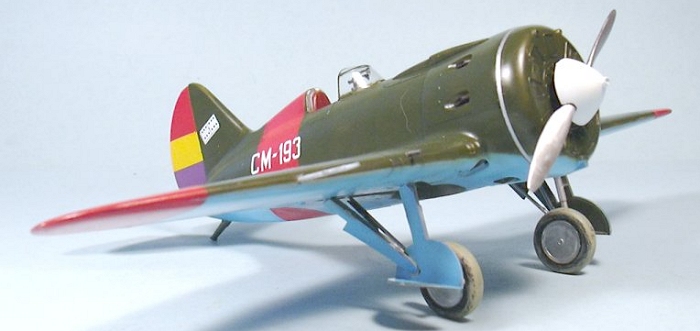
| KIT #: | ? |
| PRICE: | $41.00 MSRP |
| DECALS: | Three options |
| REVIEWER: | Tom Cleaver |
| NOTES: |

| HISTORY |
In 1932, when Nikolai Polikarpov conceived what was called the TsKB-12 - a low wing cantilever monoplane with retractable landing gear and an enclosed cockpit - Western air forces claimed their advanced status by introducing fixed-gear open-cockpit monoplanes such as the Dewoitine D.500 and the Boeing P-26. First flown on December 31, 1933, what was then known as the I-16 was the most advanced fighter aircraft in the world.
The I-16 would later be called “the Boeing,” in the mistaken belief that it
was based on Boeing’s contemporary monoplane - with which it shared only a
low-wing monoplane configuration. In the early 1930s, high speed
aerodynamics were little
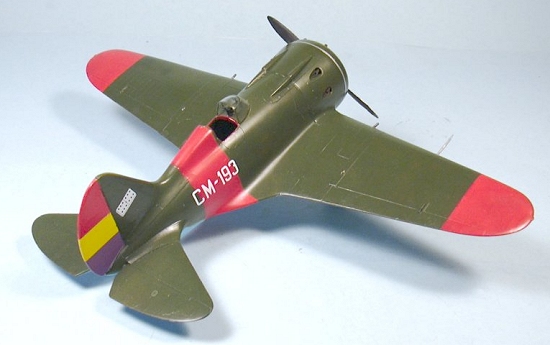 understood
and if Polikarpov’s stubby fighter shared anything in common with any
American designs, it would have been American race planes such as the Gee
Bee or the Turner Meteor, with its short-coupled design - at the time the
only way a designer knew to create speed. The I-16 additionally shared
difficult flying characteristics not all that different from its American
cousins - an American pilot who flew it in combat in Spain said of the I-16
that a pilot couldn’t take his attention off flying it for am instant
without getting into trouble.
understood
and if Polikarpov’s stubby fighter shared anything in common with any
American designs, it would have been American race planes such as the Gee
Bee or the Turner Meteor, with its short-coupled design - at the time the
only way a designer knew to create speed. The I-16 additionally shared
difficult flying characteristics not all that different from its American
cousins - an American pilot who flew it in combat in Spain said of the I-16
that a pilot couldn’t take his attention off flying it for am instant
without getting into trouble.
Armed with two unsynchronized 7.62mm ShKAS machine guns in the wings, which provided twice the rate of fire of any other aircraft machine gun in the world, the I-16 attained 224 mph at sea level and was supremely maneuverable for a monoplane.
Deliveries of the I-16 Type 1 to the V-VS began in the late summer of 1934, and it was displayed publicly for the first time at the 1935 May Day Parade, with several formations of I-16s being flown over Red Square. At this time, the RAF had yet to order the Gloster Gladiator into production, and the German Luftwaffe was only beginning to take delivery of the Heinkel He-51 to the newly formed Jagdstaffeln, while the Dewoitine D.500 had only just entered Escadrille service with the Armee de l’Air. Even with this public display, the existence of the I-16 roused no interest by Western aviation authorities, even after large numbers of the fighter took part in the large-scale autumn maneuvers held outside Kiev that year, which were attended by Western military attaches.
In February 1924, the I-16first flew with an M-25 engine - the license-built version of the Curtiss-Wright Cyclone 9, which had 50 percent more power than the M-22, and raised the I-16's top speed from 224 to 282 mph. The I-16 Type 4, which appeared in late 1935, adopted this powerplant for production.
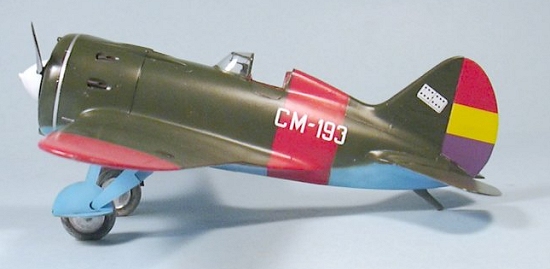 The outbreak of
the Spanish Civil War on July18, 1936, provided Germany, Italy and the
Soviet Union with the opportunity to field test their newest military
equipment. 31 I-16 Type 5 fighters were offloaded in two shipments that
arrived in the port of Alicante that October. V-VS volunteers had already
arrived and two 12-aircraft squadrons - known as Escuadrillas de Moscas
- were immediately formed. The Spanish had adopted the Russian nickname
for the I-16 - “Mushki” or “fly” - as the official name, “Mosca.”
The Escuadrillas were based at a secret airfield in Camposoto on the
estate seized from the Falangist Duke of Albuquerque, where they would
operate undiscovered for the next year.
The outbreak of
the Spanish Civil War on July18, 1936, provided Germany, Italy and the
Soviet Union with the opportunity to field test their newest military
equipment. 31 I-16 Type 5 fighters were offloaded in two shipments that
arrived in the port of Alicante that October. V-VS volunteers had already
arrived and two 12-aircraft squadrons - known as Escuadrillas de Moscas
- were immediately formed. The Spanish had adopted the Russian nickname
for the I-16 - “Mushki” or “fly” - as the official name, “Mosca.”
The Escuadrillas were based at a secret airfield in Camposoto on the
estate seized from the Falangist Duke of Albuquerque, where they would
operate undiscovered for the next year.
On November 15, 1936, two Moscas encountered three Italian C.R.32s without result. On the 16th, four Moscas flew top cover to Pavel Rychagov’s Escuadrilla de Chatos of 1-15s. The I-15s were attacked by an Italian-Spanish unit of C.R.32s that included Joaquin Garcia Morato - the future Falangist ace of aces. Two I-15s fell for three C.R.32s with the I-16s failing to engage. On the 17th five Moscas intercepting an Escuadrilla of Junkers Ju-52/3m g3e bombers were bounced by seven C.R.32s, losing one Mosca. From this point on, fights between the Moscas and the Nationalist fighters quickly demonstrated that the I-16 could hold its own with the C.R.32, and that it completely outclassed the He-51, which was so outclassed the Germans were forced to assign the He-51s to ground attack, being escorted by C.R.32s.
The appearance of the I-16 in substantial numbers in Spain resulted in the Luftwaffe sending three Bf-109 prototypes to war in February 1937, and diverting Bf-109B-2s from Luftwaffe modernization requirements to meet the threat of the Mosca for the rest of the Spanish Civil War.
The Bf-109B outperformed the I-16 the way the I-16 outperformed the Nationalist biplanes, having a higher operational ceiling than the Mosca, and a faster dive speed, which allowed a German pilot to break off combat at will, though the Mosca outperformed the German fighter in close-in high-g maneuvering combat.
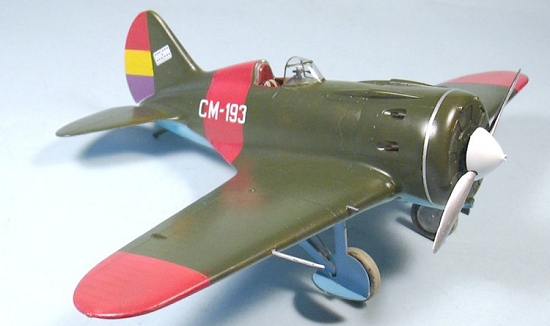 Two American
volunteers, Frank Tinker and Ajax Baumler, who had scored in the I-15
Chato, were assigned to the 1st Escuadrilla de Moscas on May
30, 1937. In his first combat flight - at the end of one day of conversion
training - Tinker participated in a combat between I-16s and C.R.32s from
the Asso di Bastoni fighter group in which the I-16s shot down nine of the
Italians for no loss. Both Tinker and Baumler went on to become aces in
the combat, making them the first two American aces in the greater struggle
that would be known as World War II.
Two American
volunteers, Frank Tinker and Ajax Baumler, who had scored in the I-15
Chato, were assigned to the 1st Escuadrilla de Moscas on May
30, 1937. In his first combat flight - at the end of one day of conversion
training - Tinker participated in a combat between I-16s and C.R.32s from
the Asso di Bastoni fighter group in which the I-16s shot down nine of the
Italians for no loss. Both Tinker and Baumler went on to become aces in
the combat, making them the first two American aces in the greater struggle
that would be known as World War II.
The I-16 Type 10, known as the “Super Mosca” for its higher-rated M-25 engine and additional two ShKAS machine guns mounted in the fuselage and firing through the propeller arc, appeared in Spain in March 1938, after the Republican loss of the Battle of Brunete the previous fall and the establishment of Falangist air superiority over the Madrid front. Following the Falangist breakthrough on the Aragon front, the six Escuadrillas de Moscas were forced to retreat continuously from base to base, with repairs and maintenance being conducted under the most primitive conditions. By July 1938 only 35 Moscas were serviceable, with 122 of the 179 delivered in the course of the struggle having been lost. 99 more Super Moscas were delivered in August and September, in time to participate in the Battle of the Ebro that had broken out in July, but too late to affect the defeat of the outnumbered Republican forces in November. Having lost 100 I-16s in the battle, the Soviets could no longer make good the losses and the Mosca units were ordered to avoid combat unless unavoidable.
The Falangist offensive against Catalonia began on December 23, 1938. The 3rd Escuadrilla de Moscas was assigned to the defense of Barcelona, losing half the force in the six days between outbreak and the fall of the city on January 25, 1939.
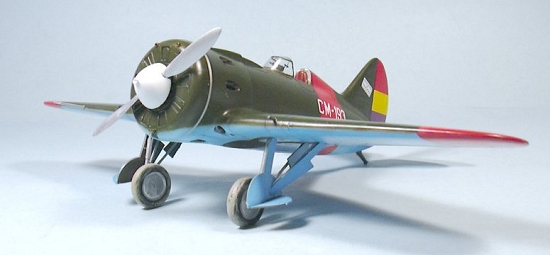 All was now
confusion, though Moscas of the
3rd Escuadrilla
shot down a Bf-109 over the Franco-Spanish border the following week before
flying across Falangist territory to bring seven I-16s to Figueras.
All was now
confusion, though Moscas of the
3rd Escuadrilla
shot down a Bf-109 over the Franco-Spanish border the following week before
flying across Falangist territory to bring seven I-16s to Figueras.
Following the defeat of the Republic on March 31, 1939, the Falangists captured 22 flyable Moscas and another 30 undergoing repairs. These aircraft were used as front-line fighters from 1941 to the early 1950s. In 1953, there was only one left, flown by the instructors at Moron and kept airworthy with many non-standard parts, such as a fuel pump from a Ju-52. The airplane was grounded on September 24, 1953, the last original I-16 flying anywhere in the world until Sir Tim Wallis would finance the restoration of three wrecks found in Kamchatka, with the I-16s returning to the skies of New Zealand in 2001.
| THE KIT |
The Azur kit is quite basic for a limited-run 1/32 kit. While the original
cockpit is primitive, the cockpit in this kit is almost non-existent, being
a floor, seat, control stick, rudder pedals and instrument panel, with some
non-descript items molded on to the c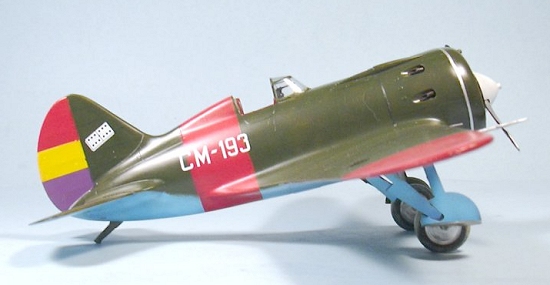 ockpit
walls. There is no engine and the front of the cowling is completely
enclosed.
ockpit
walls. There is no engine and the front of the cowling is completely
enclosed.
That said, the surface detail provided is quite nice, with good fabric detail for the wings and tail surfaces. Fit is what one expects from an MPM design - with Mr. Surfacer being needed on all seams and joints, after a good sanding-down to get things together.
Given that what one wants in 1/32 is the additional detail that comes with the increase in size, I doubt modelers who want to do this kit would complain about an extra $5 being added to the price for a more detailed resin cockpit. Those who really must have the cowl open could get hold of the old Williams Brothers 1/32 Cyclone engine to fit inside.
Decals are provided for two Spanish Republican I-16s from the 1st and 3rd Escuadrillas de Mosca, and one captured by the Falangists during the civil war.
| CONSTRUCTION |
At first I thought I might scratchbuild a more detailed cockpit, but when I
looked over the photos provided by a friend I decided I would just close up
the cockpit flaps, which would restrict the view of the interior.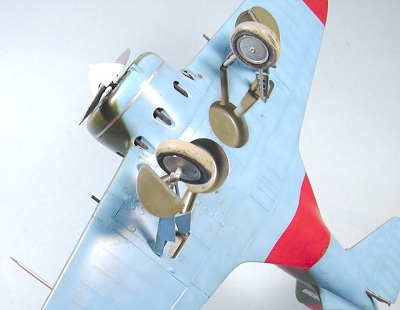
After the usual parts cleanup associated with a limited-run kit, the model went together without too much sweat and strain, and I then applied Mr. Surfacer to all the seams and joints and managed with a lot of sanding and re-application of Mr. Surfacer to obtain an acceptable-looking assembly.
| COLORS & MARKINGS |
Painting:
I painted the Republican insignia with Gunze-Sangyo “Shine Red” after putting down a white base coat. Masking these areas off, I painted the lower surfaces with Tamiya “Sky Blue” and the upper surfaces with Tamiya “Olive Green.” A coat of Future gave the model a smooth surface.
Decals:
The individual aircraft number, squadron insignia and rudder insignia were applied without problem.
| FINAL CONSTRUCTION |
I gave the model a coat of Xtracrylix Satin Varnish, and then attached the resin exhausts and the landing gear. The exhausts do not look correct for the I-16 from photos I have and a Pilot Press cutaway drawing, and the landing gear was extremely “fiddly,” with a lot of cutting and test-fitting to get it in place that included cutting off about 1/8 inch of the upper leg cover of the wheel cover to position it properly. I then attached the prop after giving the front side a polished appearance with SNJ Aluminum polishing powder.
| CONCLUSIONS |
The model is dimensionally accurate and makes up into a good looking representation of this famous fighter. As I said above, it would be better with a resin cockpit, but what is here is more than sufficient base material for a modeler with some scratchbuilding skills to work some magic inside the fuselage. At the moment, this is the most accurate I-16 kit available in any scale.
April 2005
Review kit from Hannant’s.
If you would like your product reviewed fairly and fairly quickly, please contact the editor or see other details in the Note to Contributors.